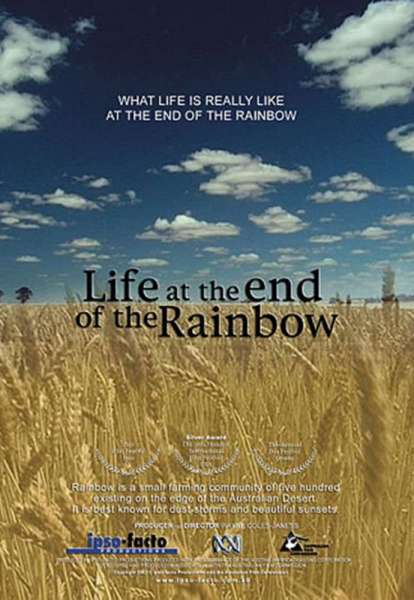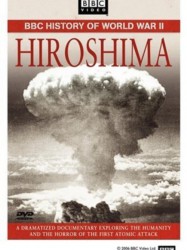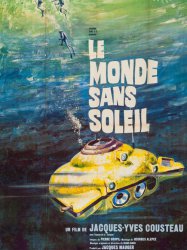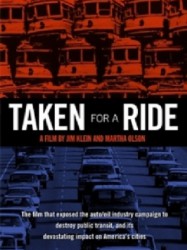Life at the End of the Rainbow est un film de genre Documentaire
Life at the End of the Rainbow (2002)

Si vous aimez ce film, faites-le savoir !
- Infos
- Casting
- Infos techniques
- Photos
- Vidéos
- Passages TV
- Citations
- Personnages
- Musique
- Récompenses
Durée 55minutes
Genres Documentaire
Life at the End of the Rainbow (2002) is a documentary by Australian filmmaker Wayne Coles-Janess about the small farming community of Rainbow, population 500, which lies on the edge of the Big Desert, North Western Victoria, Australia. It is 55 minutes long.
Synopsis
The area was originally considered worthless by European-Australian settlers, who fenced it off and abandoned it. The town was established around the start of the 20th century by German immigrant settlers. Its population increased after the first and second World Wars due to the government's policies of subsidies to encourage settlement by veterans. The people of Rainbow have struggled to eke out an existence for more than three generations, with global economics and government policy compounding the difficulties of marginal farming. The film draws from home movies from the 1940s to portray the people in this town.Commentaires
Postez un commentaire :
Suggestions de films similaires à Life at the End of the Rainbow
Il y a 8951 ayant les mêmes genres cinématographiques, 8041 films qui ont les mêmes thèmes (dont 1 films qui ont les mêmes 5 thèmes que Life at the End of the Rainbow), pour avoir au final 70 suggestions de films similaires.Si vous avez aimé Life at the End of the Rainbow, vous aimerez sûrement les films similaires suivants :

Les Seigneurs de la mer (2006)
, 1h29Réalisé par Rob Stewart
Origine Canada
Genres Documentaire
Thèmes Mise en scène d'un animal, L'environnement, La mer, Politique, Transport, Requins, Documentaire sur la protection animale, Documentaire animalier, Documentaire sur le droit, Documentaire sur l'environnement, Mise en scène d'un poisson, Politique, Documentaire sur la nature
Acteurs Trey Parker, Matt Stone, Rob Stewart
Note78%





Depuis l'enfance, Rob Stewart se passionne pour les requins. À tel point qu'il est devenu biologiste et photographe sous-marin afin de pouvoir nager avec eux, décrypter leur mystère et déconstruire le mythe du requin mangeur d'hommes. Ce mythe, entièrement fabriqué, serait selon lui responsable de l'indifférence qui entoure, un peu partout dans le monde, le massacre de la population de requins à des fins commerciales. Du Costa Rica aux Îles Galapagos en passant par le Guatemala, Stewart et l'équipage de l'activiste des mers Paul Watson tentent de dénoncer et de mettre en échec les braconniers à la solde de mafias asiatiques soutenues par des gouvernements corrompus. Il y va de l'équilibre écologique de la planète.

Voyage au bout du monde (1976)
, 1h33Réalisé par Jacques-Yves Cousteau, Philippe Cousteau, Marshall Flaum
Origine France
Genres Documentaire
Thèmes L'environnement, La mer, Transport, Documentaire sur l'environnement, Documentaire sur la nature
Note71%





En décembre 1972 la Cousteau Society entame une expédition de quatre mois sur l'Antarctique. L'expédition compte sur la collaboration du Musée océanographique de Monaco et du Muséum d'histoire naturelle de La Rochelle, ce dernier étant représenté sur place par son directeur, le professeur Raymond Duguy (1927 - 2012).

Le Dernier Continent (2007)
Genres Documentaire
Thèmes L'environnement, La mer, Transport, Documentaire sur l'environnement
Acteurs Donald Sutherland
Note67%





À bord du voilier Sedna IV, Jean Lemire et son équipe se sont engagés pour une ultime mission. Une mission extrême, 430 jours d'expédition et un hivernage en Antartique, totalement isolés, au bout du monde.Dans la foulée des grands explorateurs d'hier, ils ont repousser les limites pour livrer aux spectateurs une épopée unique, motivé par une formidable quêtes d'aventures, de découvertes et de rêves...

Hiroshima (2005)
, 1h29Origine Royaume-uni
Genres Drame, Documentaire
Thèmes L'environnement, La mer, Transport, Aviation, Documentaire sur l'environnement, Documentaire sur la guerre, Documentaire historique, Documentaire sur le nucléaire, Documentaire sur les technologies, Politique, Documentaire sur la Seconde Guerre mondiale
Acteurs John Hurt, Ed Bishop, Katsumi Chō, Naoko Mori, Ian Shaw, Shane Rimmer
Note77%





À 8h15 précises ce 6 août 1945, le monde a changé. 40.000 personnes trouvent instantanément la mort, mais ce sont bien 200.000 décès qui seront provoqués par l´explosion de la première bombe nucléaire sur Hiroshima, au Japon. Ce documentaire exceptionnel de 90 minutes n´est pas « Un énième film anti-guerre » déclare son réalisateur Paul Wilmshurst, « mais bien l´analyse neutre et objective d´une décision cruciale. Il ne s´agit pas d´être pro-américain ou pro-japonais, j´ai simplement voulu raconter la vérité. » Une vérité technologique, scientifique, militaire et politique qui se dessine dans les trois semaines précédant l´attaque, alors que le premier essai nucléaire vient de se dérouler dans le désert du Nouveau-Mexique, aux États-Unis. Le spectateur se retrouve alors dans la pièce où est prise la décision ultime, à bord de l´Enola Gay pendant son trajet fatidique, à l´intérieur de la bombe au moment de l´explosion, puis dans les rues dévastées d´Hiroshima.

Le monde sans soleil (1964)
, 1h30Réalisé par Jacques-Yves Cousteau, Albert Falco, Simone Melchior
Origine France
Genres Documentaire
Thèmes L'environnement, La mer, Transport, Documentaire sur l'environnement, Documentaire sur la nature
Note74%





En 1963, Jacques-Yves Cousteau et son équipe entament une expérience inédite : vivre un mois durant, dans un village sous-marin aménagé dans la Mer Rouge, sur les côtes du Soudan. C'est l'expérience dénommée Précontinent II.

Taken for a Ride (1996)
, 55minutesOrigine Etats-Unis
Genres Documentaire
Thèmes L'environnement, Transport, Automobile, Le train, Documentaire sur le monde des affaires, Documentaire sur l'environnement, Documentaire sur les technologies, Road movie
Note78%





Taken for a Ride begins with interviews on the inefficiencies and congestion on Los Angeles' highways. Next, the film displays a variety of archival footage on streetcar systems around the United States, demonstrating that streetcars were a widespread and efficient means of transportation. The film continues into a description of the General Motors streetcar conspiracy, starting with a history of National City Lines and Pacific City Lines and General Motors' investment in both companies. The film builds the argument that streetcar systems purchased by these companies were deliberately sabotaged through service reductions and fare increases, then replaced with profitable, less convenient, bus systems. Next, the film makes a connection between this conspiracy and the construction of the Interstate Highway System and the suburbanization of America in the face of the Highway revolts in the 1960s and 1970s. The film ends with footage of the reduction of Philadelphia's trolleybus system at the time of filming.

Réalisé par Penny Woolcock
Origine Royaume-uni
Genres Documentaire
Thèmes Mise en scène d'un animal, L'environnement, La mer, Transport, Documentaire sur l'environnement, Documentaire sur les technologies, Documentaire sur la nature
Note79%






Waterwalker (1984)
, 1h27Réalisé par Bill Mason
Origine Canada
Genres Documentaire
Thèmes L'environnement, La mer, Sport, Transport, Documentaire sur le sport, Documentaire sur l'environnement, Documentaire sur les technologies
Acteurs Bill Mason
Note80%






Océans (2010)
, 1h43Réalisé par Jacques Perrin, Jacques Cluzaud
Origine France
Genres Documentaire
Thèmes Mise en scène d'un animal, L'environnement, La mer, Transport, Documentaire animalier, Documentaire sur l'environnement, Documentaire sur la nature, Films pour enfants
Acteurs Pierce Brosnan, Jacques Perrin, Rie Miyazawa, Pedro Armendáriz (fils), Oleg Basilashvili, Jiang Wen
Note76%





Ce documentaire filme l'océan et les créatures marines. Il s'interroge également sur l'empreinte que l'homme impose à la vie sauvage et invite à la protection des océans, face à la pêche abusive, à la pollution et au réchauffement climatique.

Finding Farley (2009)
, 1h2Origine Canada
Genres Documentaire
Thèmes Film sur un écrivain, L'environnement, La mer, Sport, Transport, Documentaire sur le sport, Documentaire sur l'environnement, Documentaire sur une personnalité, Documentaire sur les technologies, Documentaire sur la nature
Note74%





 Connexion
Connexion